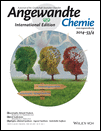Identifying Enantiomers in Mixtures of Chiral Molecules with Broadband Microwave Spectroscopy†
Financial support from the Fonds der Chemischen Industrie, the Deutsche Forschungsgemeinschaft, and the United States Department of Energy is acknowledged.
Graphical Abstract
Enantiomer differentiation, enantiomeric excess measurement, and absolute configuration determination within a mixture of gas-phase chiral molecules are demonstrated. In these experiments, microwave three-wave mixing within supersonic jets is combined with chirped-pulse broadband microwave spectroscopy. This new technique is now a significant step closer to broader application.
Abstract
Chirality-sensitive broadband microwave spectroscopy was performed on mixtures of carvone enantiomers and conformers to distinguish enantiomers, measure enantiomeric excesses, and determine the absolute configurations of the enantiomers. This method uses microwave three-wave mixing and is inherently well-suited to the analysis of mixtures—a unique advantage over other techniques. In contrast to conventional microwave spectroscopy, the phase of the received signal is also exploited. This phase depends upon the signs of the molecules’ dipole-moment components and is used to identify the excess enantiomer. The measured signal amplitude determines the size of the excess. The broadband capabilities of the spectrometer were used to simultaneously excite and measure two conformers of carvone, demonstrating the analysis of a sample with multiple chiral species. Employing quantum chemical calculations and the measured phases, the absolute configurations of the enantiomers are determined.





